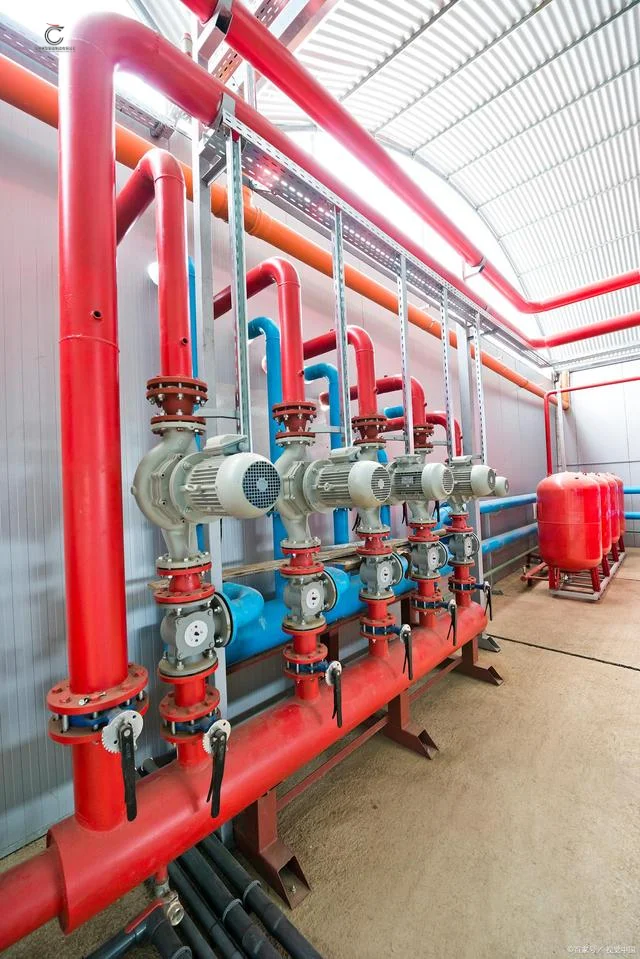Fire pipe installation construction
1. When the thread connection of the fire fighting pipeline is changed in diameter, the wire connection shall adopt the reduced pipe parts, and avoid the use of replenishment core. If you need to fill the core, the elbow should not be used up and down, only one is allowed on the three-way parts, and no more than two are allowed on the four-way parts. The threaded sealing packing shall be uniformly attached to the threaded part of the pipe. When tightening the thread, do not squeeze the sealed material into the pipe, and clean up the outside after connecting.
2. When welding and connecting the firefighting pipeline, the difference between the diameter of the reduced pipe and the diameter of the reduced pipe should not be greater than 50mm. If it is greater than 50mm, the welding of the large and small heads should be adopted.
3. casing
(1) When the pipeline passes through the wall, the casing shall be added to the floor, and the pipeline weld shall not be placed in the casing. The length of the casing shall not be less than the thickness of the wall.
(2) The floor casing should be 50mm higher than the floor or ground.
4. pipe reinforcement pipe fixed using a pipe hanger and anti-sway support, and should meet the following requirements:
(1) An anti-sway support should be installed at least on the main water distribution pipe or water distribution pipe with a pipe diameter of 50mm or more. When the pipe is too long or changes direction, an anti-sway support must be added.
(2) At least one hanger should be set up on the pipe section between the adjacent two sprinkler heads. When the nozzle spacing is less than 1.8m, it can be set in separate sections.
(3) The hanger and anti-sway support should be directly fixed on the building, and the installation position should meet the requirements of the code.
5. fire pipeline installation
(1) There should be no other water facilities on the pipeline after the alarm valve, and galvanized steel pipe or galvanized seamless steel pipe should be used.
(2) The automatic sprinkler pipe should be provided with a slope, and slope to the drainage pipe or auxiliary drainage pipe. The slope of the dry pipe of the wet system should not be less than 0.002°, and the slope of the water distribution pipe and water distribution branch pipe should not be less than 0.005°.
(3) The diameter of all water distribution pipes or water distribution branch pipes shall not be less than 25mm.
(4) The nozzle set on each side of each water distribution branch pipe shall meet the following requirements:
A. There shall be no more than 8 light hazard grade and medium hazard grade buildings and structures. When sprinklers are arranged on the upper and lower sides of the same water distribution pipe, there shall be no more than 8 sprinklers on the upper and lower sides respectively.
B. There shall be no more than 6 buildings and structures of serious danger level.
(5) The minimum distance between the center of the pipeline and the building structure shall comply with the requirements in Table 11-21.
6. The pressure relief orifice plate and the pressure relief orifice plate of the throttle device shall meet the following requirements:
(1) It shall be located on a horizontal pipe section with a diameter of 50mm or more.
(2) The orifice plate shall be installed on the downstream side of the water flow turning from the pipe section, and the distance from the elbow shall not be less than twice the diameter of the set pipe section.
(3) The length of the throttle pipe should not be less than 1.0m.
(4) The diameter of the throttle pipe should be selected according to the provisions in Table 11-22.
7. Pipe Color standard Fire water distribution pipe and water distribution pipe should be painted with a red or red ring to mark other pipes.
Cangzhou shenlong pipe manufacturing co., ltd. is a company specializing in the production, processing, and sales of various steel pipes and pipe fittings enterprise, the production base is located in Cangzhou in Hebei. Founded in 1992, covering more than 60,000 square meters, more than 200 employees (including 30 inspectors), and an annual output of around 150,000 tons of steel pipes, and 40,000 tons of pipe fittings.
What are our main products include?
Pipe Fittings: Elbows, Tees, Reducers, Flanges, etc.
Materials: Carbon Steel, Alloy Steel, Stainless Steel.
Standard: GB, ASME, DIN, JIS, EN, BS, NF, GOST, ISO, etc.
As a professional steel pipe manufacturer, we can provide First-Class Quality & Professional Technical Services!
Welcome to Contact US!
Product Application:
•WATER TREATMENT
•FIRE CONTROL
•CONSTRUCTION
•MARINE







